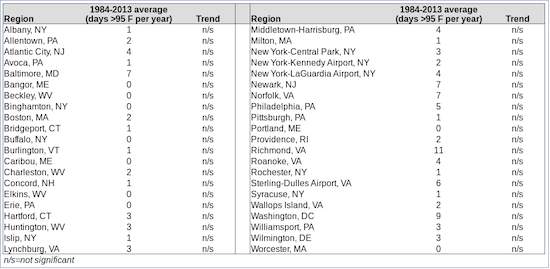By Sierra Rayne ——Bio and Archives--June 25, 2014
Global Warming-Energy-Environment | CFP Comments | Reader Friendly | Subscribe | Email Us
"Right now, the Northeast is actually rather temperate in the summer, with only 2.6 days over 95°F on average each year -- a temperature we refer to throughout our research as 'extremely hot.' By mid-century, the average resident in the Northeast will likely see between 4.7 and 16 additional extremely hot days; by late century this range will likely jump to between 17 and 59 additional extremely hot days, or up to two additional months of extreme heat."So Risky Business is projecting up "to two additional months of extreme heat" in the Northeast by sometime late in the 21st century, and up to an additional couple weeks of "extremely hot days" for this region over the next few decades. Based on these predictions, we would expect that over the past three decades -- during which time atmospheric greenhouse gas concentrations have increased rapidly -- there would be near uniform and substantial increases in the number of "extremely hot days" across the Northeast. The reality is the complete opposite. The following table shows the trends (or lack thereof) in the number of extremely hot days for the climate sub-regions throughout the Northeast during the past three decades.
 There is not a single significant trend in the number of days above 95°F per year in any sub-region of the Northeast. Not one. And yet, somehow, the region will see up to an additional two months of extremely hot days over the remainder of this century?
The real risky business is in predicting our future climate, and if past performance of climate models is any indication, we should place little -- if any -- stock in these projections.
There is not a single significant trend in the number of days above 95°F per year in any sub-region of the Northeast. Not one. And yet, somehow, the region will see up to an additional two months of extremely hot days over the remainder of this century?
The real risky business is in predicting our future climate, and if past performance of climate models is any indication, we should place little -- if any -- stock in these projections.View Comments
Sierra Rayne holds a Ph.D. in Chemistry and writes regularly on environment, energy, and national security topics. He can be found on Twitter at @srayne_ca